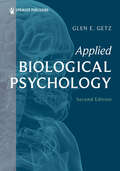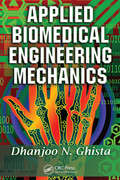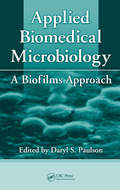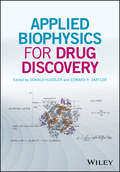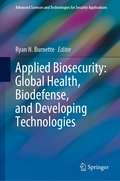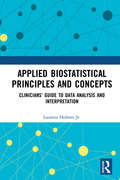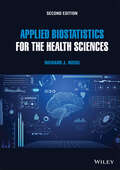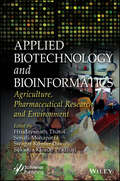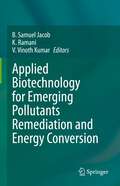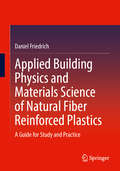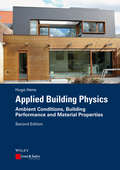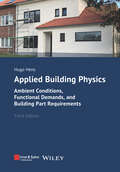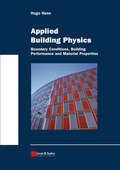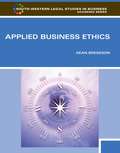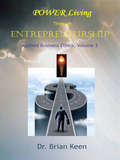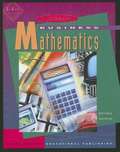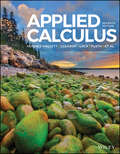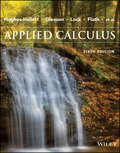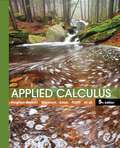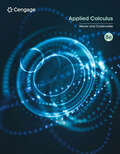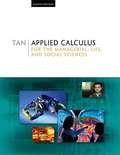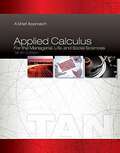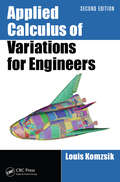- Table View
- List View
Applied Biological Psychology
by Glen E. GetzLearn how to apply neurobiology to real-world practice, moving beyond theory to understand brain-based behavior in depth. <P><P> The second edition of Applied Biological Psychology explores neuroscientific discoveries like brain imaging, genetics, and cognitive studies to understand behaviors and their connections to psychiatric diagnoses. The first section of Applied Biological Psychology introduces students to foundational neuroscientific theory and research methods, while the second section reviews literature on mood disorders, anxiety disorders, traumatic brain injuries, and other diagnostic categories. The textbook includes case examples and discussions of special topics and ethics to enhance understanding and emphasizes differences and commonalities across diagnoses. Practical applications and ethical considerations in the second edition help bridge the gap between neuroscience theory and psychological practice.
Applied Biomedical Engineering Mechanics
by Dhanjoo GhistaPresenting the latest innovations, this text highlights advances in tissue, musculoskeletal, locomotive, orthopedic, occupational, ergonomic, sports, cardiovascular, cardiac, and pulmonary biomechanics. Based on years of teaching experience, the author uses illustrative examples and detailed explanations to show how mechanics disciplines can be applied to a wide range of clinical applications, including the analysis of physiological and organ-system processes; the creation of physiologically compatible organ-assist systems and devices; the performance of pre-surgical analysis in order to develop optimal surgical approaches; and the design of vehicle-occupant systems for occupant comfort.
Applied Biomedical Microbiology: A Biofilms Approach
by Daryl S. PaulsonFrom the slippery covering on rocks in a stream, to the clogging slime in a bathtub drain, biofilms are present in everyday life in a variety of forms. This seemingly harmless build-up also accounts for 80 percent of all microbial infections. With chapters authored by experienced contributors from academia and industry, Applied Biomedical Microbiol
Applied Biophysics for Drug Discovery
by Donald Huddler Edward E. ZartlerApplied Biophysics for Drug Discovery is a guide to new techniques and approaches to identifying and characterizing small molecules in early drug discovery. Biophysical methods are reasserting their utility in drug discovery and through a combination of the rise of fragment-based drug discovery and an increased focus on more nuanced characterisation of small molecule binding, these methods are playing an increasing role in discovery campaigns. This text emphasizes practical considerations for selecting and deploying core biophysical method, including but not limited to ITC, SPR, and both ligand-detected and protein-detected NMR. Topics covered include: • Design considerations in biophysical-based lead screening • Thermodynamic characterization of protein-compound interactions • Characterizing targets and screening reagents with HDX-MS • Microscale thermophoresis methods (MST) • Screening with Weak Affinity Chromatography • Methods to assess compound residence time • 1D-NMR methods for hit identification • Protein-based NMR methods for SAR development • Industry case studies integrating multiple biophysical methods This text is ideal for academic investigators and industry scientists planning hit characterization campaigns or designing and optimizing screening strategies.
Applied Biosecurity: Global Health, Biodefense, and Developing Technologies (Advanced Sciences and Technologies for Security Applications)
by Ryan N. BurnetteThis book describes an adaptable biothreat assessment process to complement overall biorisk management programs, incorporating threat management and the unique natures of biological assets. Further, this book examines the nexus between public health, international security, and developing technologies, building a case for augmenting biosecurity to levels beyond the laboratory constraints. With the face of biological and biomedical sciences changing, this book describes how with proper biosecurity development, these can become assets, rather than liabilities, to secure our world from natural and man-made biological disasters. The world is changing rapidly with respect to developing threats, such as terrorism, and dual-use technologies, such as synthetic biology, that are challenging how we think about biosafety and biosecurity. Further, the fields of public health and international security are colliding, as both of these share the common enemy: intentional or natural biological incidents. To date, biosecurity has been limited to laboratory-level application, and complicating efforts, and lacks credentialed biosecurity professionals skilled in both the biological sciences and threat management techniques. The result is a fragmented field of practice, with tremendous need, from the lab to the outbreak. Underpinning these principles is the SARS-CoV-2 coronavirus pandemic, providing a historic milestone to examine biosecurity through a global lens. This book describes biosecurity as a set of practices and principles to be augmented out of the constrained laboratory environment, and applied to larger efforts, such as international threat reduction and biological incident management.
Applied Biostatistical Principles and Concepts: Clinicians' Guide to Data Analysis and Interpretation
by Laurens Holmes, Jr.The past three decades have witnessed modern advances in statistical modeling and evidence discovery in biomedical, clinical, and population-based research. With these advances come the challenges in accurate model stipulation and application of models in scientific evidence discovery Applied Biostatistical Principles and Concepts provides practical knowledge using biological and biochemical specimen/samples in order to understand health and disease processes at cellular, clinical, and population levels. Concepts and techniques provided will help researchers design and conduct studies, then translate data from bench to clinics in attempt to improve the health of patients and populations. This book is suitable for both clinicians and health or biological sciences students. It presents the reality in statistical modelling of health research data in a concise manner that will address the issue of "big data" type I error tolerance and probability value, effect size and confidence interval for precision, effect measure modification and interaction as well as confounders, thus allowing for more valid inferences and yielding results that are more reliable, valid and accurate.
Applied Biostatistics for the Health Sciences
by Richard J. RossiAPPLIED BIOSTATISTICS FOR THE HEALTH SCIENCES APPLIED BIOSTATISTICS FOR THE HEALTH SCIENCES In this newly revised edition of Applied Biostatistics for the Health Sciences, accomplished statistician Dr. Richard Rossi delivers a robust and easy-to-understand exploration of statistics in the context of applied health science and biostatistics. The book covers sample design, logistic regression, experimental design, survival analysis, basic statistical computation, and many more topics with a strong focus on the correct use and interpretation of statistics. The author also explains how to assess the quality of observed data, how to collect quality data, and the use of confidence intervals in conjunction with hypothesis and significance tests. A thorough introduction to biostatistics, including explanations of fundamental concepts like populations, samples, statistics, biomedical studies, and data set examples A comprehensive exploration of population descriptions, including qualitative and quantitative variables, multivariate data, measures of dispersion, and probability Practical discussions of random sampling, summarizing random samples, and the measurement of the reliability of statistics In-depth examinations of confidence intervals, statistical hypothesis testing, simple and multiple linear regression, and experimental design Perfect for health science and biostatistics students and professors at the upper undergraduate and graduate levels, Applied Biostatistics for the Health Sciences is also a must-read reference for practitioners and professionals in the fields of pharmacy, biochemistry, nursing, health care informatics, and the applied health sciences.
Applied Biotechnology and Bioinformatics: Agriculture, Pharmaceutical Research and Environment
by Swagat Kumar Das Hrudayanath Thatoi Sonali Mohapatra Sukanta Kumar PradhanThis comprehensive reference book discusses the convergent and next-generation technologies for product-derived applications relevant to agriculture, pharmaceuticals, nutraceuticals, and the environment. The field of modern biotechnology is a multidisciplinary and groundbreaking area of biology that includes several cutting-edge methods due to developments in forensics and molecular modeling. Bioinformatics is a full-fledged multidisciplinary field that combines advances in computer and information technology. Numerous applications of bioinformatics—primarily in the areas of gene and protein identification, structural and functional prediction, drug development and design, folding of genes and proteins and their complexity, vaccine design, and organism identification—have contributed to the advancement of biotechnology. Biotechnology is also essential to crop improvement in agriculture because it allows genes to transfer across plants to increase traits such as disease resistance and yield. It also plays a broad role in healthcare, including genetic testing, gene therapy, pharmacogenomics, and drug development. Bioremediation and biodegradation, using microbial technologies to clean up environmental contamination, waste management technologies, and the conversion of organic waste to biofuels. Bioinformatics plays a critical role in analyzing different types of data created by high-throughput research methods—such as genomic, transcriptomic, and proteomic datasets—that are useful in addressing various problems related to disease management, clean environment, alternative energy sources, agricultural productivity, and more. Audience The book will interest biotechnology researchers and bioinformatics professionals working in the areas of applied biotechnology, bioengineering, biomedical sciences, microbiology, agriculture and environmental sciences.
Applied Biotechnology for Emerging Pollutants Remediation and Energy Conversion
by B. Samuel Jacob K. Ramani V. Vinoth KumarThis contributed volume comprises of detailed chapters covering the biotechnological approaches employed for the removal of toxic recalcitrant xenobiotics such as petroleum hydrocarbons, textile dyes, microplastics and synthetic polymers that pose serious threat to the environment. It also includes the waste to energy conversion strategies that provides a deep insight on the need for waste circular economy for different developing countries and its implication on sustainable development goals such as SDG 12 (responsible consumption and production) SDG 14 (Life below water); and SDG 15 (Life on land). Emerging pollutants sourced from both industries and anthropogenic activity have created havoc in recent years for public health and destruction of biodiversity at multiple levels. The alarming increase in the global population and rapid industrialization might aggravate the problems associated with these hazardous pollutants in near future. Effluent from different industries may contain high amounts of xenobiotic hazardous contaminants such as dyes, hydrocarbons, synthetic surfactants, microplastics, etc. Industries and public sewers handling such waste streams are facing a plethora of challenges in the effluent treatment and solid waste disposal due to various factors that start from production to adoption of appropriate technologies. Therefore, there is an immediate circumvention of bottlenecks through sustainable mitigation strategies. This book is of interest to teachers, researchers, climate change scientists, capacity builders and policymakers. Also, the book serves as additional reading material for undergraduate and graduate students of agriculture, forestry, ecology, soil science, and environmental sciences. National and international agricultural scientists, policy makers also find this to be a useful read.
Applied Building Physics and Materials Science of Natural Fiber Reinforced Plastics: A Guide for Study and Practice
by Daniel FriedrichThe transfer of theoretical learning content to the practical application of previously unregulated bio-based building materials is the focus of this technical book. To this end, planning and design principles of thermal, moisture and sound insulation are presented and demonstrated using new types of natural fibre-reinforced plastics (NFK) in façade applications. Results from current research on LFPs and in particular on wood-plastic composites (WPC) are explained in a comprehensible way and presented graphically. It is aimed at students of architecture and civil engineering and offers numerous exam-like exercises and sample solutions to reinforce the contents. Students learn the basics of building physics and practise their application to concrete problems in building design. In addition, they can repeat and consolidate their acquired knowledge in a variety of exercises with a high level of practical relevance. Specialist planners will gain new perspectives on the selection of materials and their use in building components with the potential for more sustainability in the building industry.
Applied Building Physics: Ambient Conditions, Building Performance and Material Properties
by Hugo S. HensBad experiences with construction quality, the energy crises of 1973 and 1979,complaints about `sick buildings?, thermal, acoustical, visual and olfactory discomfort, the need for good air quality, the move towards more sustainability ? all these have accelerated the development of a field that, for a long time, was hardly more than an academic exercise: building physics. The discipline embraces domains such as heat and mass transfer, building acoustics, lighting, indoor environmental quality and energy efficiency. In some countries, fire safety is also included. Through the application of physical knowledge and its combination with information coming from other disciplines, the field helps to understand the physical phenomena governing building parts, building envelope, whole building and built environment performance, although for the last the wording `urban physics? is used. Building physics has a real impact on performance-based building design. This volume on `Applied Building Physics? discusses the heat, air and moisture performance metrics that affect building design, construction and retrofitting.
Applied Building Physics: Ambient Conditions, Functional Demands, and Building Part Requirements
by Hugo S. HensWhile the first volume on building physics deals with the physical principles of heat, air and moisture behaviour of buildings, building structures and components, this second volume on applied building physics focuses on the question of what the desired performance of buildings consists of. To achieve this, knowledge of the external environmental effects and the internal live loads to which buildings are subjected is a necessary first step. Subsequently, the performance requirements and the physical correspondences are deepened with the determination of their physical parameters, at the levels of buildings, building structures and building components. Compared to the second edition, the discussion of criteria is not limited to thermal comfort, but also includes acoustic, visual and olfactory aspects. Likewise, the indoor air quality is considered in a broader way. Analyses and calculations result in sustainable buildings with a comfortable indoor climate from functional and durable building constructions. Compared to the second edition, the text for the third edition has been reorganised, corrected, revised and expanded where appropriate. A useful appendix for quick reference contains standard values of material properties for a wide range of building materials. The analyses and calculations described in this book result in sustainable buildings made of functional and durable building constructions, with comfortable and healthy indoor climate and air quality. Compared to the second edition the text in this third edition has been reshuffled, corrected, reworked and extended where appropriate.
Applied Building Physics: Boundary Conditions, Building Performance and Material Properties
by Hugo S. HensThe energy crises of the 1970s, persisting moisture problems, complaints about sick buildings, thermal, visual and olfactory discomfort, and the move towards more sustainability in building construction have pushed Building Physics to the forefront of building innovation. The societal pressure to diminish energy consumption in buildings without impairing usability acted as a trigger to activate the whole notion of performance based design and construction. As with all engineering sciences, Building Physics is oriented towards application, which is why, after a first book on fundamentals this second volume examines performance rationale and performance requirements. Outdoor and indoor climate conditions are described and calculation values are discussed, the performance concept is specified at the building level and at the building envelope level, and heat-air-moisture material properties are defined. The book incorporates 35 years of teaching Building Physics to architectural, building and civil engineers, bolstered by 40 years of experience, research and consultancy.
Applied Business Ethics
by Dean A. BredesonThe text applies practical ethical situations to real-world business settings and decisions. The text contains thought-provoking scenarios with up-to-the-minute issues that encourage active debate among peers.
Applied Business Ethics, Volume 2: POWER Living Through Entrepreneurship
by Dr Brian KeenThis is the second book in the Applied Business Ethics series. The first volume featured the Truth, while this volume features Entrepreneurship. The Theanthropic Ethical category is one of the few scientific ethical categories. Entrepreneurs will appreciate the fact that our work is evaluated by a fellow entrepreneur, who is an ethicist by profession. Entrepreneurs drive our business communities through resolving problems. This creates wealth for all stakeholders. All successful entrepreneurs establish enterprises that are based on ethical standards. For entrepreneurs the best ethical standards are based upon scientifically verifiable, objective standards. Theanthropic Ethics© is one of the few ethical categories that entrepreneurs can depend on. Through case studies of Canadian enterprises started by entrepreneurs, you will see how some enterprises have achieved success for centuries. All were initially successful because they implemented ethical standards. Theanthropic Ethics© is thoroughly evaluated within the context of entrepreneurship. You will see that freedom is an essential component for all entrepreneurs to become successful. Three Canadian enterprises are evaluated as case studies to show the benefits of being ethical.
Applied Business Mathematics
by Robert A. Schultheis Raymond M. KaczmarskiHelps students to assess what they've learned by providing excercises pertaining to what was learned in each chapter. Includes true/false, short answer, multiple choice, etc. questions.
Applied Business Mathematics (14th Edition)
by Robert A. Schultheis Raymond M. KaczmarskiThis classic, newly-revised book presents fundamental mathematics in the context of business and consumer applications to help put readers on the path to success. The all-new 1997 edition improves upon previous editions with a wealth of updated features. The material in Applied Business Mathematics will teach the student, the mathematical and critical thinking skills that will help him be a smart shopper, an informed citizen, and a valued employee.
Applied Calculus
by Eric Connally Karen Rhea Deborah Hughes-Hallett Daniel E. Flath Andrew M. Gleason Brigitte Lahme Patti Frazer Lock Douglas Quinney David O. Lomen David Lovelock Jeff Tecosky-Feldman Thomas W. Tucker Adam H. Spiegler William G. McCallum Brad G. Osgood Guadalupe I. Lozano Cody L. Patterson Aaron D. Wootton Ayşe Şahin Selin KalaycıoğluApplied Calculus
by Deborah Hughes-Hallett Daniel E. Flath Andrew M. Gleason Patti Frazer LockA text for interactive Calculus courses, featuring innovative problems This sixth edition of Applied Calculus engages students with well-constructed problems and content to deepen understanding. The Rule of Four approach is supported in the text, where concepts are presented graphically, numerically, symbolically, and verbally. Students with a range of learning styles will be able to progress in the subject as they are exposed to a range of exercises.
Applied Calculus
by Hughes-HallettApplied Calculus is praised for the creative and varied conceptual and modeling problems which motivate and challenge students. The 5th Edition of this market leading text exhibits the same strengths from earlier editions including the "Rule of Four," an emphasis on concepts and modeling, exposition that students can read and understand and a flexible approach to technology. Updated data and fresh applications throughout the book are designed to build student confidence with basic concepts and to reinforce skills. As in the previous edition, a Pre-test is included for students whose skills may need a refresher prior to taking the course.
Applied Calculus
by Steven R. Costenoble Stefan WanerLearn how to think and act like an effective marketer and forward-focused disruptor in today's dynamic, fast-paced business environment with Ferrell/Hartline/Hochstein’s MARKETING STRATEGY, 8E. You learn to develop long-term, customer-oriented marketing strategy and successful marketing plans with this edition's systematic, reader-friendly approach. The latest examples from organizations as familiar as Spotify, Nintendo and Microsoft work with updated vignettes and the latest research and data. New cases from Tesla, Netflix and even the recent COVID-19 pandemic clearly illustrate the need for marketers to think proactively and anticipate change. You examine today's trends, from strategic digital marketing tools and integrated marketing communication to new marketing models. This edition also discusses product labeling, social media segmentation, crisis preparedness and innovation in global marketing as you learn to analyze, plan and implement effective marketing strategies.
Applied Calculus for the Managerial, Life, and Social Sciences
by S. T. TanWell known for accuracy, Soo Tan's APPLIED CALCULUS FOR THE MANAGERIAL, LIFE, AND SOCIAL SCIENCES, Eighth Edition balances applications, pedagogy, and technology to provide students the context they need to stay motivated in the course and interested in the material. Accessible for majors and non-majors alike, the text uses an intuitive approach that introduces abstract concepts through examples drawn from common, real-life experiences to which students can relate. It also draws applications from readers' fields of interest. In addition, insightful Portfolios highlight the careers of real people and discuss how they incorporate math into their daily operations. Numerous exercises-including new Diagnostic Tests-ensure students have a solid understanding of concepts before advancing to the next topic. Algebra review notes, keyed to the review chapter Preliminaries, appear where students need them, when they need them. Bringing powerful resources to students' fingertips, the text's exciting array of supplements, including Enhanced Web Assign, equips students with extensive learning support to help them maximize their study time.
Applied Calculus for the Managerial, Life, and Social Sciences
by Soo T. TanWell known for accuracy, Soo Tan's APPLIED CALCULUS FOR THE MANAGERIAL, LIFE, AND SOCIAL SCIENCES, Eighth Edition balances applications, pedagogy, and technology to provide students the context they need to stay motivated in the course and interested in the material. Accessible for majors and non-majors alike, the text uses an intuitive approach that introduces abstract concepts through examples drawn from common, real-life experiences to which students can relate. It also draws applications from readers' fields of interest. In addition, insightful Portfolios highlight the careers of real people and discuss how they incorporate math into their daily operations. Numerous exercises-including new Diagnostic Tests-ensure students have a solid understanding of concepts before advancing to the next topic. Algebra review notes, keyed to the review chapter Preliminaries, appear where students need them, when they need them. Bringing powerful resources to students' fingertips, the text's exciting array of supplements, including Enhanced Web Assign, equips students with extensive learning support to help them maximize their study time.
Applied Calculus for the Managerial, Life, and Social Sciences: A Brief Approach
by Soo TanAPPLIED CALCULUS FOR THE MANAGERIAL, LIFE, AND SOCIAL SCIENCES: A BRIEF APPROACH, Tenth Edition balances modern applications, solid pedagogy, and the latest technology to engage students and keep them motivated in the course. Suitable for majors and non-majors alike, the text uses an intuitive approach that teaches concepts through examples drawn from real-life situations from students' fields of interest. In addition, insightful Portfolios highlight the careers of real people and discuss how they incorporate math into their daily professional activities. Numerous exercises, including a Diagnostic Test, ensure that students have a concrete understanding of concepts before advancing to the next topic. The text's pedagogical features coupled with an exciting array of supplements equip students with the tools they need to make the most of their study time and to succeed in the course.
Applied Calculus of Variations for Engineers
by Louis KomzsikThe purpose of the calculus of variations is to find optimal solutions to engineering problems whose optimum may be a certain quantity, shape, or function. Applied Calculus of Variations for Engineers addresses this important mathematical area applicable to many engineering disciplines. Its unique, application-oriented approach sets it apart from the theoretical treatises of most texts, as it is aimed at enhancing the engineer’s understanding of the topic.This Second Edition text:Contains new chapters discussing analytic solutions of variational problems and Lagrange-Hamilton equations of motion in depthProvides new sections detailing the boundary integral and finite element methods and their calculation techniquesIncludes enlightening new examples, such as the compression of a beam, the optimal cross section of beam under bending force, the solution of Laplace’s equation, and Poisson’s equation with various methodsApplied Calculus of Variations for Engineers, Second Edition extends the collection of techniques aiding the engineer in the application of the concepts of the calculus of variations.
